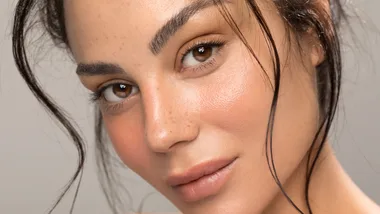It wasn’t all that long ago that Botox was considered somewhat ‘taboo’, frequently associated with frozen faces and the Real Housewives. Now? The treatment is as commonplace as a haircut, with increasingly younger women opting for the injectable, hoping to mitigate wrinkles before they form.
But does ‘preventative Botox‘ actually work?
Here, we spoke to leading Australian dermatologist Dr. Shyamalar Gunatheesan to understand everything there is to know about the anti-ageing treatment, from how it works to whether it’s truly worth your money.
What Is Preventative Botox?
Before we dive into all the ins-and-outs of this popular cosmetics procedure, it’s vital to understand what it actually entails. According to Dr. Gunatheesan, preventative Botox works on the theory that commencing regular Botox injections prior to the appearance of wrinkles—usually in one’s late twenties—will actually prevent the onset of said wrinkles and fine lines.
“Botox blocks the nerve signals to the dynamic muscles of facial expression, which [in theory] should then limit the repetitive movement and subsequent wrinkling of the overlying skin,” Dr. Gunatheesan tells marie claire.
How Often Do You Need Botox For It To be ‘Preventative’?
One facet of the treatment that is often left out of discussions about preventative Botox is that how often it’s needed to be considered ‘preventative’ will vary from person to person. Generally speaking, however, the time frames recommended are between three and six months, Dr. Gunatheesan notes.
“It would be different in each person based on which muscles are hyperactive and the way each person frowns, squints, etc.,” she explains.
“Ideally, I would recommend seeing a dermatologist, highly skilled in facial anatomy, who can assess your needs, muscle movement and baseline skin canvas. I would not be using more than 20 units per session.”
Like the amount required and the time frame, the cost will vary from person to person, with most providers charging anywhere between $8 to $25 per unit, totalling anywhere from $240 to $400 per treatment.
Does Preventative Botox Actually Work?
The question of whether preventative Botox actually works is a fair and valid one, particularly as the costs do add up. As for Dr. Gunatheesan’s take on it? It’s not worth all the hype.
“Most young people do not need preventative Botox,” she says.
“The suppleness and good reserve of collagen and elastin means that expressive lines and muscle movement do not stay etched. The ability of the skin to bounce back is still stellar. I would recommend starting with a tertiary complex vitamin A or retinoid at night instead, in conjunction with vitamin B3, vitamin C and sunscreen in the day. Invest in an evidence based skincare instead.”
Moreover, there’s no real way to tell whether early commencement of Botox in your twenties will necessarily have a significant, long-term impact on your skin when you’re older.
“You cannot be sure. Lines and wrinkles are not purely from dynamic muscle contractions, but also due to sun damage and intrinsic ageing or senescence (deterioration at the cellular level),” she says.
That said, there are a few exceptions where preventative Botox may offer greater long-term benefits.
“There will be young individuals with asymmetric muscle overactivity, gummy smiles or excessive frowning that might benefit from Botox to retrain these muscles,” Dr. Gunatheesan adds.
Wrinkles Aside, Are There Any Other Upsides To Preventative Botox?
While it’s generally touted as a line-reducing treatment, early use of Botox could help with a number of other skin issues.
“Using specialised techniques and delivery systems where the Botox is placed in small aliquots into the dermis (deeper layer of the skin as opposed into the muscle), preventative botox could temporarily reduce the appearance of pores, improve skin texture and redness of the skin,” Dr. Gunatheesan says.
What Are The Downsides To Preventative Botox?
How’s this for a contradiction: too much Botox can actually make you look older. According to Dr. Gunatheesan, there is such a thing as overdoing it, and excessive use of Botox can contribute to the progressive weakening and atrophy of the injected muscles, and may even cause the formation of new lines.
“The muscles also weaken naturally over time, so why add to that by overdoing Botox?” she says.
“The other potential problem can be the recruitment of surrounding muscles giving rise to new lines such as bunny lines or under eyelid wrinkling,” she adds.
What Are Some Alternatives To Preventative Botox?
It’s not all doom and gloom, but the reality is that ageing is going to happen all of us. You can, however, deal with fine lines and wrinkles through strong, evidence-based skincare, Dr. Gunatheesan advises. As for non-invasive treatments that could take the place of preventative Botox?
“Micro-focussed Ultrasound and infrared wavelength light therapy are non-invasive technology aimed at minimising fine lines and wrinkles,” Dr. Gunatheesan recommends.










